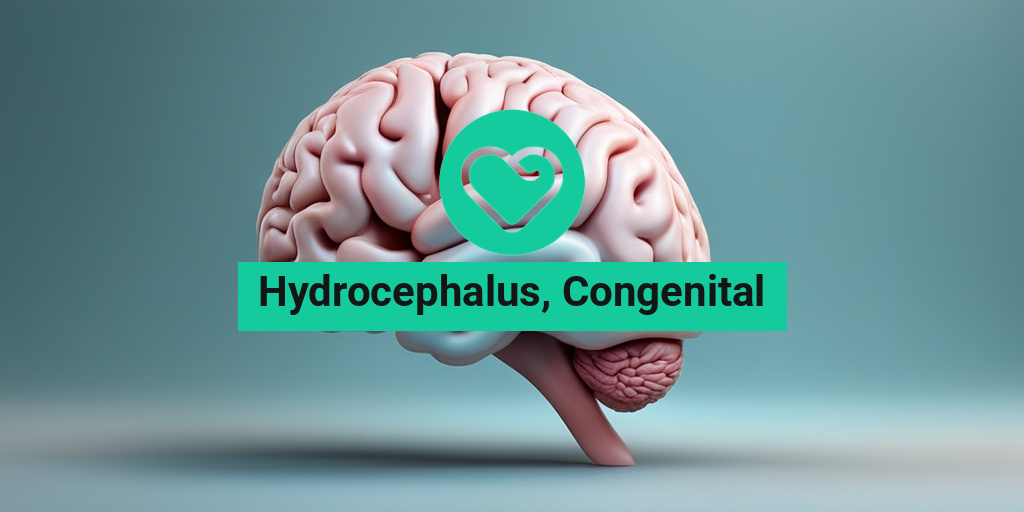What Is Congenital Hydrocephalus?
Congenital hydrocephalus is a rare but serious condition that affects newborn babies. It occurs when there is an abnormal accumulation of cerebrospinal fluid (CSF) in the brain, leading to increased pressure and potentially causing brain damage. This condition is present at birth, hence the term “congenital.” In this article, we’ll delve into the world of congenital hydrocephalus, exploring its causes, symptoms, diagnosis, and treatment options.
Causes of Congenital Hydrocephalus
The exact cause of congenital hydrocephalus is often unknown, but several factors can contribute to its development. These include:
- Infections during pregnancy, such as toxoplasmosis or rubella, which can increase the risk of congenital hydrocephalus.
- Genetic mutations, which can affect the development of the brain and nervous system.
- Aqueductal stenosis, a narrowing of the aqueduct of Sylvius, a channel that allows CSF to flow through the brain.
- Abnormalities in brain development, such as those caused by chromosomal abnormalities or other genetic disorders.
Symptoms of Congenital Hydrocephalus
The symptoms of congenital hydrocephalus can vary depending on the severity of the condition and the age of the child. Common symptoms include:
- Enlarged head size, which may be noticeable at birth or develop over time.
- Vomiting, which can be a sign of increased pressure in the brain.
- Sleepiness or lethargy, which can indicate brain damage or pressure.
- Seizures, which can occur due to abnormal brain activity.
- Developmental delays, which can affect cognitive, motor, and language skills.
Understanding Hydrocephalus in Infants
Hydrocephalus in infants is a complex condition that requires prompt medical attention. If left untreated, it can lead to serious complications, including brain damage, developmental delays, and even death. In this section, we’ll explore the diagnosis and treatment options for congenital hydrocephalus in infants.
Diagnosis of Congenital Hydrocephalus
The diagnosis of congenital hydrocephalus typically involves a combination of physical examinations, medical imaging, and laboratory tests. These may include:
- Ultrasound or MRI scans, which can help identify abnormalities in the brain and ventricles.
- CT scans, which can provide detailed images of the brain and skull.
- Genetic testing, which can help identify underlying genetic mutations or chromosomal abnormalities.
Treatment Options for Congenital Hydrocephalus
The treatment of congenital hydrocephalus usually involves surgery to drain excess CSF from the brain and relieve pressure. The goal of treatment is to:
- Reduce pressure on the brain, which can help prevent further damage.
- Improve cognitive and motor function, which can enhance the child’s quality of life.
- Manage symptoms, such as seizures or developmental delays, through medication and therapy.
If you or a loved one has been diagnosed with congenital hydrocephalus, it’s essential to seek guidance from a qualified healthcare professional. They can help you navigate the complex world of hydrocephalus and provide personalized advice and support. Additionally, resources like Yesil Health AI (yesilhealth.com) can offer evidence-based health answers and support throughout your journey.
Remember, every child with congenital hydrocephalus is unique, and their treatment plan should be tailored to their individual needs. With the right medical care and support, many children with congenital hydrocephalus can lead happy, healthy lives. 💕

Causes of Congenital Hydrocephalus
Congenital hydrocephalus is a complex condition that can occur due to various genetic and environmental factors. While the exact cause of congenital hydrocephalus is still not fully understood, research has identified several potential causes and risk factors that contribute to its development.
Genetic Mutations
Genetic mutations play a significant role in the development of congenital hydrocephalus. These mutations can affect the genes responsible for brain development, leading to abnormalities in the structure and function of the brain. Some genetic syndromes, such as X-linked hydrocephalus, are known to increase the risk of congenital hydrocephalus.
Infections During Pregnancy
Certain infections during pregnancy, such as toxoplasmosis, can increase the risk of congenital hydrocephalus. Toxoplasmosis is a parasitic infection that can be transmitted to the fetus through the placenta, causing damage to the developing brain.
Bleeding in the Brain
Bleeding in the brain, also known as intracranial hemorrhage, can occur during fetal development or shortly after birth. This bleeding can lead to the accumulation of cerebrospinal fluid in the brain, resulting in hydrocephalus.
Abnormal Brain Development
Abnormalities in brain development, such as aqueductal stenosis, can also contribute to congenital hydrocephalus. Aqueductal stenosis is a narrowing or blockage of the aqueduct of Sylvius, a channel that connects the third and fourth ventricles in the brain, leading to the accumulation of cerebrospinal fluid.
Risk Factors for Developing Hydrocephalus
In addition to the causes mentioned above, certain risk factors can increase the likelihood of developing congenital hydrocephalus.
Family History
If there is a family history of hydrocephalus or other neurological disorders, the risk of developing congenital hydrocephalus may be higher.
Maternal Infections
Maternal infections, such as rubella or cytomegalovirus, during pregnancy can increase the risk of congenital hydrocephalus.
Premature Birth
Babies born prematurely are at a higher risk of developing congenital hydrocephalus due to the increased risk of bleeding in the brain and other complications.
Multiple Births
Twins or other multiple births may be at a higher risk of developing congenital hydrocephalus due to the increased risk of genetic mutations and other complications during fetal development.
Understanding the causes and risk factors of congenital hydrocephalus is crucial for early detection and treatment. If you or a loved one has been diagnosed with congenital hydrocephalus, it’s essential to work with a healthcare team to develop a personalized treatment plan. 💊

Symptoms of Congenital Hydrocephalus
Congenital hydrocephalus is a condition where there is an accumulation of cerebrospinal fluid (CSF) in the brain, which can lead to increased pressure and damage to the brain tissue. The symptoms of congenital hydrocephalus can vary depending on the severity of the condition and the age of the individual. In this section, we will discuss the common symptoms of congenital hydrocephalus.
Physical Symptoms
Infants with congenital hydrocephalus may exhibit the following physical symptoms:
- Enlarged Head Size: One of the most noticeable symptoms of congenital hydrocephalus is an enlarged head size. This is due to the accumulation of CSF in the brain, which can cause the head to grow at an abnormal rate.
- Bulging Soft Spots: The soft spots on an infant’s head, also known as fontanelles, may bulge outward due to the increased pressure.
- Vomiting: Infants with congenital hydrocephalus may experience vomiting, which can be a sign of increased pressure in the brain.
- Sleepiness: Babies with congenital hydrocephalus may be sleepier than usual, which can be a sign of increased pressure in the brain.
- Irritability: Infants with congenital hydrocephalus may be irritable and fussy, which can be a sign of discomfort or pain.
Developmental Delays
In addition to physical symptoms, infants with congenital hydrocephalus may also experience developmental delays, including:
- Delayed Motor Skills: Infants with congenital hydrocephalus may experience delayed motor skills, such as sitting, standing, and walking.
- Delayed Speech and Language: Congenital hydrocephalus can also cause delayed speech and language development.
- Cognitive Delays: In some cases, congenital hydrocephalus can cause cognitive delays, including learning disabilities and intellectual disabilities.
Diagnosing Hydrocephalus in Newborns
Diagnosing congenital hydrocephalus in newborns is crucial to ensure timely treatment and prevent further complications. In this section, we will discuss the methods used to diagnose hydrocephalus in newborns.
Physical Examination
A physical examination is the first step in diagnosing congenital hydrocephalus. During the examination, the doctor will:
- Measure Head Circumference: The doctor will measure the head circumference to check for any abnormalities.
- Check for Bulging Soft Spots: The doctor will check for bulging soft spots on the infant’s head.
- Look for Other Signs: The doctor will look for other signs of congenital hydrocephalus, such as vomiting, sleepiness, and irritability.
Imaging Tests
If the physical examination suggests congenital hydrocephalus, the doctor may order imaging tests to confirm the diagnosis. These tests may include:
- Ultrasound: An ultrasound uses high-frequency sound waves to produce images of the brain and detect any abnormalities.
- CT Scan: A CT scan uses X-rays and computer technology to produce detailed images of the brain.
- MRI: An MRI uses a strong magnetic field and radio waves to produce detailed images of the brain.
These imaging tests can help the doctor confirm the diagnosis of congenital hydrocephalus and determine the severity of the condition. 💊

Treatment Options for Congenital Hydrocephalus
Congenital hydrocephalus is a complex condition that requires individualized treatment plans. The goal of treatment is to manage the condition, alleviate symptoms, and improve the quality of life for individuals affected. In this section, we’ll explore the various treatment options available for congenital hydrocephalus.
Surgical Interventions
Surgery is often the primary treatment option for congenital hydrocephalus. The type of surgery depends on the severity of the condition, the age of the individual, and the underlying cause of the hydrocephalus. The most common surgical interventions include:
- Shunt placement: A shunt is a device that helps drain excess cerebrospinal fluid (CSF) from the brain to another part of the body, such as the abdomen, where it can be absorbed. Shunts are usually placed in the ventricles of the brain and connected to a catheter that drains the CSF.
- Endoscopic third ventriculostomy (ETV): This minimally invasive procedure involves creating a hole in the floor of the third ventricle to allow CSF to flow out of the ventricles and into the surrounding brain tissue.
- Ventriculoperitoneal shunt (VPS): This type of shunt is used to drain CSF from the ventricles to the peritoneal cavity, where it can be absorbed.
Non-Surgical Interventions
In some cases, non-surgical interventions may be recommended to manage congenital hydrocephalus. These may include:
- Medications: Diuretics, such as acetazolamide, may be prescribed to reduce the production of CSF and alleviate symptoms.
- Rehabilitation therapy: Physical, occupational, and speech therapy can help individuals with congenital hydrocephalus develop skills and adapt to their condition.
- Monitoring and follow-up: Regular monitoring and follow-up appointments with healthcare professionals are crucial to track the progression of the condition and adjust treatment plans as needed.
Managing Hydrocephalus in Children
Congenital hydrocephalus can have a significant impact on a child’s development, growth, and quality of life. Managing the condition requires a multidisciplinary approach that involves healthcare professionals, parents, and caregivers. Here are some tips for managing hydrocephalus in children:
Early Intervention
Early intervention is critical in managing congenital hydrocephalus in children. This includes:
- Regular check-ups: Regular appointments with healthcare professionals to monitor the child’s condition and adjust treatment plans as needed.
- Developmental assessments: Regular assessments to track the child’s developmental progress and identify any delays or challenges.
Support and Resources
Managing congenital hydrocephalus in children requires a support system that includes:
- Families and caregivers: Educating families and caregivers about the condition, its management, and the importance of follow-up appointments.
- Support groups: Connecting with support groups and online communities to share experiences, ask questions, and receive emotional support.
- Healthcare teams: Collaborating with healthcare teams, including neurosurgeons, pediatricians, and therapists, to develop a comprehensive treatment plan.
By understanding the treatment options and management strategies for congenital hydrocephalus, individuals and families can better navigate this complex condition and improve the quality of life for those affected 💕.

Frequently Asked Questions about Hydrocephalus, Congenital
What is Congenital Hydrocephalus?
Congenital hydrocephalus is a condition where there is an abnormal accumulation of cerebrospinal fluid (CSF) in the brain, which occurs during fetal development or is present at birth. This can lead to increased pressure on the brain and potentially cause brain damage.
What are the Causes of Congenital Hydrocephalus?
The exact causes of congenital hydrocephalus are not fully understood, but it is believed to be related to genetic mutations, infections during pregnancy, and other factors. In some cases, it can be caused by toxoplasma infection or other infections during pregnancy.
What are the Symptoms of Congenital Hydrocephalus?
Symptoms of congenital hydrocephalus can vary depending on the severity of the condition and the age of diagnosis. In infants, symptoms may include a large head size, vomiting, sleepiness, and seizures. In adults, symptoms may include headaches, vision problems, and difficulty with coordination and balance.
How is Congenital Hydrocephalus Diagnosed?
Congenital hydrocephalus can be diagnosed through imaging tests such as ultrasound, CT scans, and MRI. In some cases, a diagnosis may not be made until adulthood, when symptoms become apparent.
What are the Treatment Options for Congenital Hydrocephalus?
Treatment for congenital hydrocephalus usually involves the placement of a shunt, which is a device that helps to drain excess CSF from the brain. In some cases, surgery may be necessary to remove a blockage in the brain or to repair a defect.
Can I Get Life Insurance with Congenital Hydrocephalus?
It may be possible to get life insurance with congenital hydrocephalus, but it may depend on the severity of the condition and other factors. It’s best to consult with an insurance professional to discuss your options.
What is the Prognosis for Congenital Hydrocephalus?
The prognosis for congenital hydrocephalus varies depending on the severity of the condition and the effectiveness of treatment. With proper treatment, many people with congenital hydrocephalus can lead normal lives. However, some may experience ongoing health problems and developmental delays.
Where Can I Find Support for Congenital Hydrocephalus?
There are many resources available for people with congenital hydrocephalus, including support groups, online forums, and organizations such as the Hydrocephalus Association. It’s important to connect with others who understand what you’re going through.
Can Congenital Hydrocephalus be Prevented?
While congenital hydrocephalus cannot be completely prevented, there are steps that can be taken to reduce the risk of developing the condition. These include getting regular prenatal care, avoiding infections during pregnancy, and getting vaccinated against certain diseases.
What is the ICD-10 Code for Congenital Hydrocephalus?
The ICD-10 code for congenital hydrocephalus is Q03.0. This code is used to classify the condition for medical billing and insurance purposes.
What is Aqueductal Stenosis in Relation to Congenital Hydrocephalus?
Aqueductal stenosis is a condition where the aqueduct of Sylvius, a narrow channel in the brain, is narrowed or blocked, leading to a buildup of CSF. This can cause congenital hydrocephalus and is often treated with a shunt or other surgical procedures.
Can Congenital Hydrocephalus be Treated with Radiology?
Radiology plays a crucial role in the diagnosis and treatment of congenital hydrocephalus. Imaging tests such as ultrasound, CT scans, and MRI are used to diagnose the condition and monitor its progression. In some cases, radiology may be used to guide surgical procedures or other treatments.




